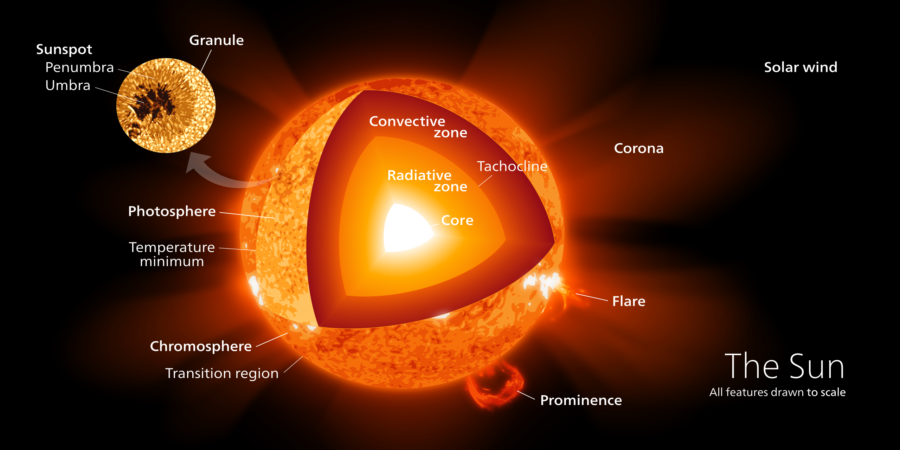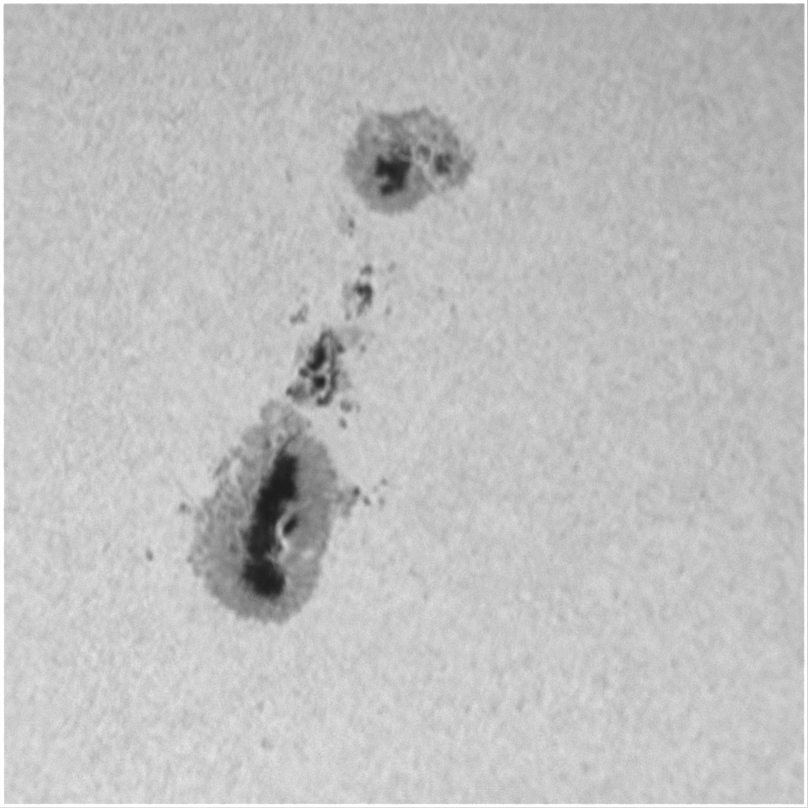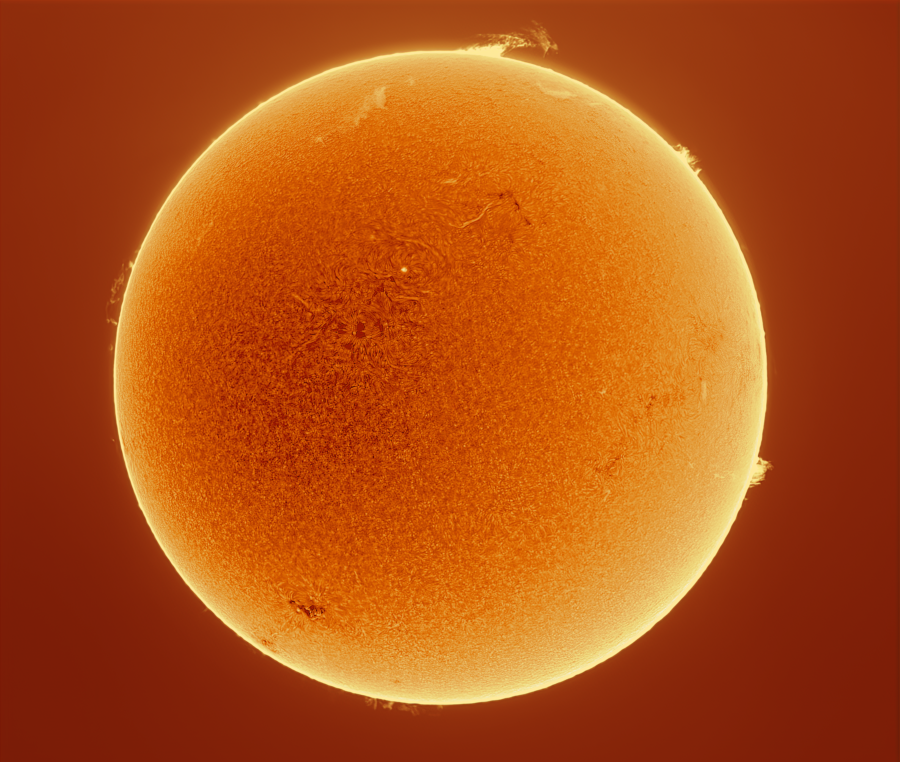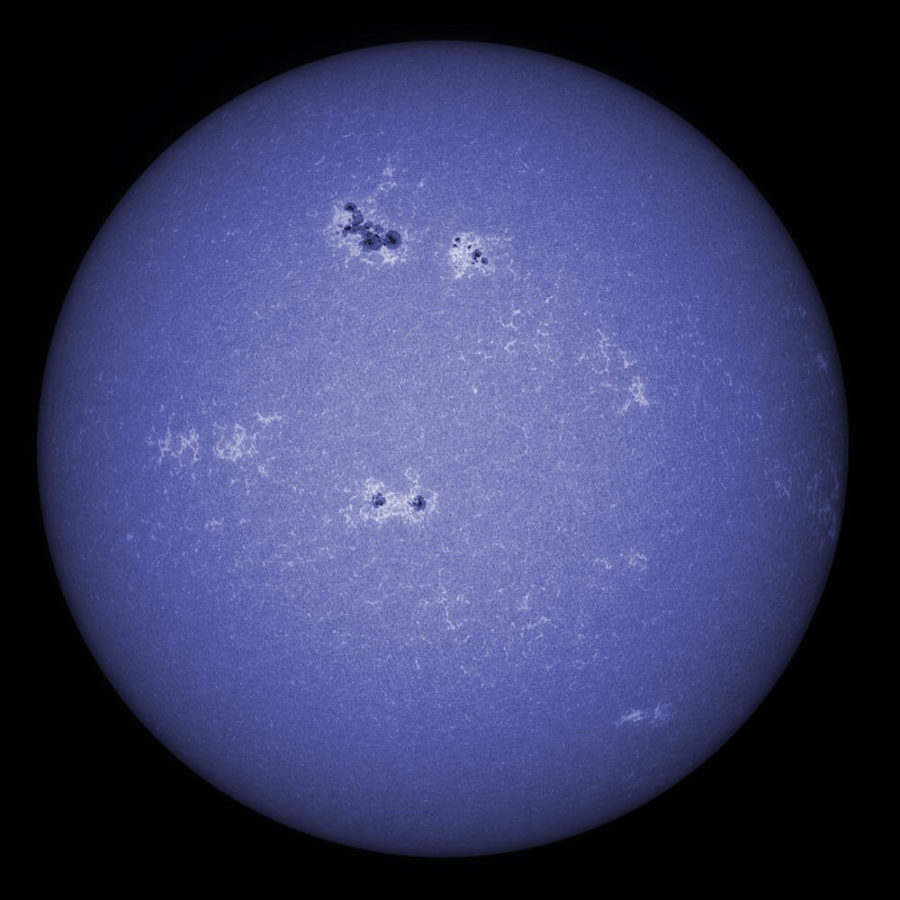
Viewing with White Light Telescopes
White light viewing gives us a broadband view of the Sun’s photosphere layer.
The Sun emits 400 trillion watts of energy per second in a wide range of wavelengths, from infrared to visual to ultraviolet and beyond. As opposed to H-Alpha viewing which zeroes in on a narrow red band, and Ca-K viewing which zeroes in on a narrow blue band, white light viewing lets through a broad range of visible light.

View or image the Sun in white light with a Lunt White Light Module or White Light Front-Mounted Filter!
The Lunt White Light Module




To view the Sun via white light with your Lunt Universal Telescope, remove the H-alpha module and blocking filter, then attach a Lunt White Light Module to the focuser. This diagonal-type solar filter inserts into the focuser of your telescope for safe viewing of eclipses, sun spots, and more. It also works with standard nighttime telescopes.
Through white light viewing, you’ll see sunspots, faculae and granulation. You’ll be able to see the umbra, the dark core of sunspots, and the penumbra, the hotter surrounding region. Faculae are hot areas and granulation are 1000-mile-wide plasma bubbles that last 10-20 minutes.
It’s thrilling to watch solar activity with white light viewing, then to see the continuation of that activity in other layers via H-Alpha and Ca-K. All of them plus more are possible with Lunt Universal Telescopes!

All solar telescopes must have a blocking filter.
The Lunt White Light Wedge comes with a built-in ND3 filter. Notably, this allows perfectly safe imaging or visual solar observation.
Alternatively, if you wish to do visual observing we recommend dimming the image for your eyes with a polarizing filter. First put one polarizing filter on the bottom of your eyepiece. Then adjust the brightness to your comfort by rotating the eyepiece.
Required Equipment By Viewing Type
A telescope needs different equipment installed depending on what type of viewing you’re doing. Here’s a complete list of what you’ll need for your Lunt Universal Telescope:
| Viewing Type | Required | Recommended | Accessories |
|---|---|---|---|
| H-alpha | Lunt Universal Day & Night OTA | Sol Searcher (standard on some Lunt OTAs) | Lunt H-alpha Double Stack Module |
| Lunt H-alpha Module | Lunt Zoom Eyepiece | Lunt PC1: Computer Controlled Pressure Tuning | |
| Lunt Blocking Filter | Tracking Mount | Barlow Lens | |
| Standard Eyepiece | BinoViewer | ||
| Dovetail | |||
| Mount | |||
| CaK | Lunt Universal Day & Night OTA | Sol Searcher (standard on some Lunt OTAs) | Barlow Lens |
| Lunt CaK Rear Module | Lunt Zoom Eyepiece | BinoViewer | |
| Standard Eyepiece | Tracking Mount | ||
| Dovetail | |||
| Mount | |||
| White Light | Lunt Universal Day & Night OTA | Sol Searcher (standard on some Lunt OTAs) | Barlow Lens |
| Front Mount or Rear Mount White Light Filter or Wedge | Lunt Zoom Eyepiece | BinoViewer | |
| Polarizing Filter | Tracking Mount | ||
| Standard Star Diagonal (If using front mount filter) | |||
| Standard Eyepiece | |||
| Dovetail | |||
| Mount | |||
| Lunar, Planetary, Deep Space | Lunt Universal Day & Night OTA | Red Dot Finder | Coma Corrector (for larger OTAs) |
| Standard Star Diagonal | Go-To Mount | Light Pollution Filter | |
| Standard Eyepiece | Lunt Zoom Eyepiece | BinoViewer | |
| Dovetail | |||
| Mount | |||
| Terrestrial | Lunt Universal Day & Night OTA | Lunt Zoom Eyepiece | |
| Standard Image Erecting Diagonal (45 degree recommended) | BinoViewer | ||
| Standard Eyepiece | |||
| Dovetail | |||
| Manual Mount |
Lunt Front-Mounted DoubleStack Filters also can be added to standard refractor telescopes to enable you to use your nighttime scope as an H-alpha scope. You’ll need a an adapter to mount the unit to the objective, and a Lunt Blocking Filter.
For your safety: After nighttime viewing, be sure to set up your Universal Telescope with the required solar modules before viewing the Sun!
Industry-Leading Quality and Safety

High Safety Standards
At Lunt Solar safety is our top priority. When Lunt Solar started making solar telescopes and filters, the subject of eye safety was at the forefront of our design. Our designs were approved by a senior ophthalmologist professor at a leading university of ophthalmology in Canada. A safety criterion was determined for both UV and IR transmission. This criterion basically set the bar at less than 1×10-5 (T) for any hazardous radiation.
Several standalone filters in Lunt products meet this criterion as a single unit. However, Lunt sets double and sometime triple standards for this requirement so that in the unlikely event one filter fails, the user will still be fully protected.
Because of the addition of multiple filters and safety features, a person simply standing in the sunlight will receive more ambient UV and IR radiation to the eye than when they are looking through one of our solar telescopes.
Lens Coating:
Lunt purchases our raw etalon glass materials from an ISO-qualified company on the East Coast of the United States. We grind, edge, bevel, and polish all the glass needed for the etalon and filter systems in-house in Tucson, AZ. Some coatings are outsourced to a facility that maintains a coating specific to our requirements.
Our coating facility has the required ability to produce anti-reflective coating at less than 0.1% reflectivity (R) (typically in the 0.06%R range). They also hold the high reflector coatings to better than +/-1%. The ability to control the coating processes to such high accuracy has allowed us to make precision modifications to the coating formulas, which have proven to increase contrast through the reduction of background noise.
Quality Assurance:
Each coating batch is provided with full scans of the coating applied and is certified to meet any and all safety requirements. Some of our precision-coated filters are provided to us from a US military-qualified company who provides full military certifications with every filter.
All Lunt Solar products are 100% safe when used as directed and are shipped from the factory free of any damage or defects. If a Lunt instrument is ever dropped or damaged, it should be returned to the factory for testing and re-certification.
Due to different optical arrangements in each design, a Lunt solar product should never be mixed and matched with components made by other companies.
One of the most important questions to ask when looking at a Solar Telescope is whether or not is has taken your safety into the highest consideration.
Does the system have redundant safety features to protect you if something should fail?
Does the system come with a Blocking Filter that contains additional safety features?

